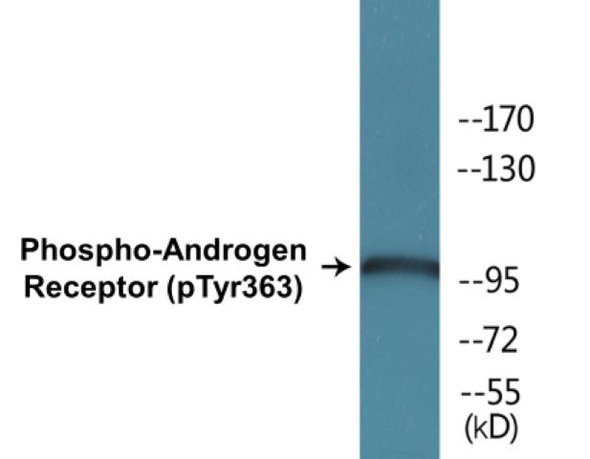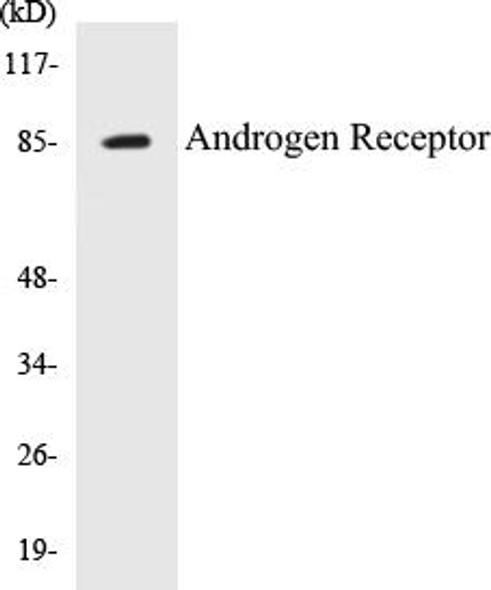Androgen Receptor (Phospho-Tyr363) Fluorometric Cell-Based ELISA Kit
- SKU:
- FBCAB00092
- Product Type:
- ELISA Kit
- ELISA Type:
- Cell Based Phospho Specific
- Reactivity:
- Human
- Mouse
- Rat
- Detection Method:
- Fluorometric
Description
Androgen Receptor (Phospho-Tyr363) Cell-Based ELISA Kit
The Androgen Receptor (Phospho-Tyr363) Cell-Based ELISA Kit is a convenient, lysate- free, high throughput and sensitive assay kit that can monitor Androgen Receptor phosphorylation and expression profile in cells. The kit can be used for measuring the relative amounts of phosphorylated Androgen Receptor in cultured cells as well as screening for the effects that various treatments, inhibitors (ie. siRNA or chemicals), or activators have on Androgen Receptor phosphorylation.
How does our Androgen Receptor (Phospho-Tyr363) Fluorometric Cell-Based ELISA Kit work?
Qualitative determination of Androgen Receptor (Phospho-Tyr363) concentration is achieved by an indirect ELISA format. In essence, Androgen Receptor (Phospho-Tyr363) is captured by Androgen Receptor (Phospho-Tyr363)-specific primary (1°) antibodies while Dye 1-conjugated and Dye 2-conjugated secondary (2°) antibodies bind the Fc region of the 1° antibody. Through this binding, the dye conjugated to the 2° antibody can emit light at a certain wavelength given proper excitation, hence allowing for a fluorometric detection method. Due to the qualitative nature of the Cell-Based ELISA, multiple normalization methods are needed:
| 1. | A monoclonal antibody specific for human GAPDH is included to serve as an internal positive control in normalizing the target RFU values. |
| 2. | An antibody against the nonphosphorylated counterpart of Androgen Receptor (Phospho-Tyr363) is also provided for normalization purposes. The RFU values obtained for non-phosphorylated Androgen Receptor can be used to normalize the RFU value for phosphorylated Androgen Receptor. |
Androgen Receptor (Phospho-Tyr363) Fluorometric Cell-Based ELISA Kit -Information
| Product Name: | Androgen Receptor (Phospho-Tyr363) Fluorometric Cell-Based ELISA Kit |
| Product Code/SKU: | FBCAB00092 |
| Description: | The Androgen Receptor (Phospho-Tyr363) Fluorometric Cell-Based Phospho ELISA Kit is a convenient, lysate-free, high throughput and sensitive assay kit that can monitor Androgen Receptor (Phospho-Tyr363) protein phosphorylation and expression profile in cells. The kit can be used for measuring the relative amounts of phosphorylated Androgen Receptor (Phospho-Tyr363) in cultured cells as well as screening for the effects that various treatments, inhibitors (ie. siRNA or chemicals, or activators have on AR phosphorylation. |
| Dynamic Range: | > 5000 Cells |
| Detection Method: | Fluorometric |
| Storage/Stability: | 4°C/6 Months |
| Reactivity: | Human, Mouse, Rat |
| Assay Type: | Cell-Based ELISA |
| Database Links: | Gene ID: 367, UniProt ID: P10275, OMIM #: 109200/300068/312300/313200/313700, Unigene #: Hs.496240 |
| Format: | Two 96-Well Plates |
| NCBI Gene Symbol: | AR |
| Sub Type: | Phospho |
| Target Name: | Phospho-Androgen Receptor (Tyr363) |
Kit Principle
Figure: Schematic representation of Assay Genie Cell-Based Fluorometric ELISA principle
Kit components | Quantity |
| 96-Well Black Cell CultureClear-Bottom Microplate | 2 plates |
| 10X TBS | 24 ml |
| Quenching Buffer | 24 ml |
| Blocking Buffer | 50 ml |
| 15X Wash Buffer | 50 ml |
| Primary Antibody Diluent | 12 ml |
| 100x Anti-Phospho Target Antibody | 60 µl |
| 100x Anti-Target Antibody | 60 µl |
| Anti-GAPDH Antibody | 110 µl |
| Dye-1 Conjugated Anti-Rabbit IgG Antibody | 6 ml |
| Dye-2 Conjugated Anti-Mouse IgG Antibody | 6 ml |
| Adhesive Plate Seals | 2 seals |
Additional equipment and materials required
The following materials and/or equipment are NOT provided in this kit but are necessary to successfully conduct the experiment:
- Fluorescent plate reader with two channels at Ex/Em: 651/667 and 495/521
- Micropipettes capable of measuring volumes from 1 µl to 1 ml
- Deionized or sterile water (ddH2O)
- 37% formaldehyde (Sigma Cat# F-8775) or formaldehyde from other sources
- Squirt bottle, manifold dispenser, multichannel pipette reservoir or automated microplate washer
- Graph paper or computer software capable of generating or displaying logarithmic functions
- Absorbent papers or vacuum aspirator
- Test tubes or microfuge tubes capable of storing ≥1 ml
- Poly-L-Lysine (Sigma Cat# P4832 for suspension cells)
- Orbital shaker (optional)
Kit Protocol
This is a summarized version of the kit protocol. Please view the technical manual of this kit for information on sample preparation, reagent preparation and plate lay out.
| 1. | Seed 200 µl of desired cell concentration in culture medium into each well of the 96-well plates. For suspension cells and loosely attached cells, coat the plates with 100 µl of 10 µg/ml Poly-L-Lysine (not included) to each well of a 96-well plate for 30 minutes at 37°C prior to adding cells. |
| 2. | Incubate the cells for overnight at 37°C, 5% CO2. |
| 3. | Treat the cells as desired. |
| 4. | Remove the cell culture medium and rinse with 200 µl of 1x TBS, twice. |
| 5. | Fix the cells by incubating with 100 µl of Fixing Solution for 20 minutes at room temperature. The 4% formaldehyde is used for adherent cells and 8% formaldehyde is used for suspension cells and loosely attached cells. |
| 6. | Remove the Fixing Solution and wash the plate 3 times with 200 µl 1x Wash Buffer for 3 minutes. The plate can be stored at 4°C for a week. |
| 7. | Add 100 µl of Quenching Buffer and incubate for 20 minutes at room temperature. |
| 8. | Wash the plate 3 times with 1x Wash Buffer for 3 minutes each time. |
| 9. | Dispense 200 µl of Blocking Buffer and incubate for 1 hour at room temperature. |
| 10. | Wash 3 times with 200 µl of 1x Wash Buffer for 3 minutes each time. |
| 11. | Add 50 µl of Primary Antibody Mixture P to corresponding wells for Androgen Receptor (Phospho-Tyr363) detection. Add 50 µl of Primary Antibody Mixture NP to the corresponding wells for total Androgen Receptor detection. Cover the plate with parafilm and incubate for 16 hours (overnight) at 4°C. If the target expression is known to be high, incubate for 2 hours at room temperature. |
| 12. | Wash 3 times with 200 µl of 1x Wash Buffer for 3 minutes each time. |
| 13. | Add 50 ul of Secondary Antibody Mixture to corresponding wells and incubate for 1.5 hours at room temperature in the dark. |
| 14. | Wash 3 times with 200 µl of 1x Wash Buffer for 3 minutes each time. |
| 15. | Read the plate(s) at Ex/Em: 651/667 (Dye 1) and 495/521 (Dye 2). Shield plates from direct light exposure. |
| 16. | Wash 3 times with 200 µl of 1x Wash Buffer for 5 minutes each time. |
Androgen Receptor (Phospho-Tyr363) - Protein Information
| UniProt Protein Function: | AR: a nuclear hormone receptor and transcription factor. Regulates gene expression and affects cellular proliferation and differentiation in target tissues. Two splice-variant isoforms have been described. |
| UniProt Protein Details: | Protein type:Transcription factor; Nuclear receptor; DNA-binding Chromosomal Location of Human Ortholog: Xq12 Cellular Component: nucleoplasm; protein complex; cytoplasm; nuclear chromatin; nucleus Molecular Function:protein dimerization activity; protein binding; ligand-dependent nuclear receptor activity; androgen receptor activity; enzyme binding; DNA binding; androgen binding; zinc ion binding; beta-catenin binding; chromatin binding; transcription factor binding; transcription factor activity; receptor binding Biological Process: prostate gland development; transcription initiation from RNA polymerase II promoter; intracellular receptor-mediated signaling pathway; transcription, DNA-dependent; positive regulation of transcription, DNA-dependent; signal transduction; protein oligomerization; activation of NF-kappaB transcription factor; negative regulation of integrin biosynthetic process; cell proliferation; cell-cell signaling; transport; androgen receptor signaling pathway; positive regulation of cell proliferation; positive regulation of transcription from RNA polymerase III promoter; gene expression; steroid hormone mediated signaling; positive regulation of transcription from RNA polymerase II promoter; positive regulation of integrin biosynthetic process; cell growth; sex differentiation; positive regulation of phosphorylation Disease: Androgen Insensitivity Syndrome; Prostate Cancer; Androgen Insensitivity, Partial; Hypospadias 1, X-linked; Spinal And Bulbar Muscular Atrophy, X-linked 1 |
| NCBI Summary: | The androgen receptor gene is more than 90 kb long and codes for a protein that has 3 major functional domains: the N-terminal domain, DNA-binding domain, and androgen-binding domain. The protein functions as a steroid-hormone activated transcription factor. Upon binding the hormone ligand, the receptor dissociates from accessory proteins, translocates into the nucleus, dimerizes, and then stimulates transcription of androgen responsive genes. This gene contains 2 polymorphic trinucleotide repeat segments that encode polyglutamine and polyglycine tracts in the N-terminal transactivation domain of its protein. Expansion of the polyglutamine tract causes spinal bulbar muscular atrophy (Kennedy disease). Mutations in this gene are also associated with complete androgen insensitivity (CAIS). Two alternatively spliced variants encoding distinct isoforms have been described. [provided by RefSeq, Jul 2008] |
| UniProt Code: | P10275 |
| NCBI GenInfo Identifier: | 113830 |
| NCBI Gene ID: | 367 |
| NCBI Accession: | P10275.2 |
| UniProt Secondary Accession: | P10275,Q9UD95, A2RUN2, B1AKD7, |
| UniProt Related Accession: | P10275 |
| Molecular Weight: | 44,643 Da |
| NCBI Full Name: | Androgen receptor |
| NCBI Synonym Full Names: | androgen receptor |
| NCBI Official Symbol: | AR |
| NCBI Official Synonym Symbols: | KD; AIS; TFM; DHTR; SBMA; HYSP1; NR3C4; SMAX1; HUMARA |
| NCBI Protein Information: | androgen receptor; androgen nuclear receptor variant 2; dihydrotestosterone receptor; nuclear receptor subfamily 3 group C member 4 |
| UniProt Protein Name: | Androgen receptor |
| UniProt Synonym Protein Names: | Dihydrotestosterone receptor; Nuclear receptor subfamily 3 group C member 4 |
| Protein Family: | Allatostatin |
| UniProt Gene Name: | AR |
| UniProt Entry Name: | ANDR_HUMAN |







